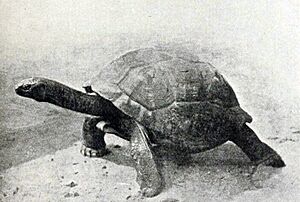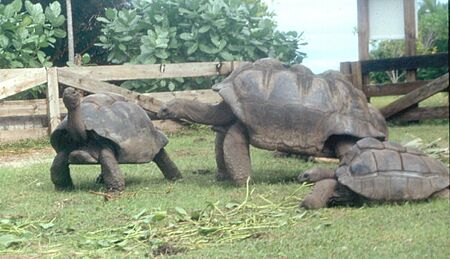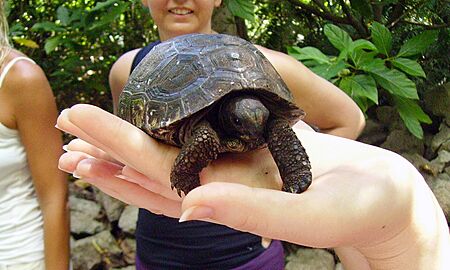Seychelles giant tortoise facts for kids
Quick facts for kids Seychelles giant tortoise |
|
|---|---|
 |
|
| A living specimen | |
| Scientific classification |
|
| Kingdom: | Animalia |
| Phylum: | Chordata |
| Class: | Reptilia |
| Order: | Testudines |
| Suborder: | Cryptodira |
| Family: | Testudinidae |
| Genus: | Aldabrachelys |
| Species: | |
| Subspecies: |
A. g. hololissa
|
| Trinomial name | |
| Aldabrachelys gigantea hololissa (Günther, 1877)
|
|
| Synonyms | |
|
|
The Seychelles giant tortoise (Aldabrachelys gigantea hololissa), also known as the Seychelles domed giant tortoise, is a tortoise subspecies in the genus Aldabrachelys.
It inhabited the large central granitic Seychelles islands, but was hunted in vast numbers by European sailors. By around 1840 it was presumed to be extinct, along with the Arnold's giant tortoise, a subspecies which shared the same islands.
It was recently rediscovered. Currently, a little over a hundred individuals exist. Many had been reestablished in the wild on forested islands such as Silhouette, but were evicted in 2011 by the Seychelles Islands Development Company.
Description
The three Aldabra-Seychelles giant tortoise subspecies can be distinguished based on carapace shape, however, many captive animals may have distorted carapaces and so may be difficult to identify.
The Seychelles giant tortoise (A. g. hololissa) is broad, flattened on the back and with raised scutes; it is usually a brownish-grey color. In comparison, the true Aldabra giant tortoise (A. g. gigantea) is a roundly-domed, black-colored subspecies.
Diet
Like other species of tortoise, the Seychelles giant tortoise is not strictly herbivorous. There have been anecdotal reports of tortoises consuming birds, crabs, and bones.
Lifespan
Giant tortoises are among the longest-lived animals on the planet. Some individual Aldabra giant tortoises are thought to be over 200 years of age, but this is difficult to verify because they tend to outlive their human observers. Adwaita was reputedly one of four brought by British seamen from the Seychelles Islands as gifts to Robert Clive of the British East India Company in the 18th century, and came to Calcutta Zoo in 1875. At his death in March 2006 at the Kolkata (formerly Calcutta) Zoo in India, Adwaita is reputed to have reached the longest ever measured life span of 255 years (birth year 1750). As of 2025, Jonathan, a 193-year-old, Saint Helena-dwelling Seychelles giant tortoise, is thought to be the oldest living terrestrial animal on Earth since the 2006 death of Harriet; a 176 year old Galapagos giant tortoise who lived at Australia Zoo. Coming in second to Jonathan is Esmeralda, at 181 years old. Esmeralda is an Aldabra giant tortoise living in the Galapagos Islands. There is a report that a tortoise was kept in the garrison by French explorer Chevalier Marc-Joseph Marion du Fresne. The creature lived in the fort for 118 years. It died in 1918 when it became blind and accidentally fell to its death from atop a gun turret.
Extinction and rediscovery
Originally, several different subspecies of giant tortoise inhabited the Seychelles. Large and slow, the tortoises were reportedly friendly, with little fear of man. Sailors and settlers slaughtered thousands and swiftly drove most populations to extinction.
Though generally assumed that the Aldabra giant tortoise was the only one to have survived over-exploitation in the Seychelles, it is occasionally, most recently in 1995, suggested that some Seychelles granitic island tortoises survived in captivity. The report of oddly shaped captive tortoises prompted the Nature Protection Trust of Seychelles to examine the identity of the living tortoises. Examination of museum specimens of the 'extinct' Seychelles subspecies by Dr. Justin Gerlach and Laura Canning confirmed that some living tortoises exhibited characteristics of the supposedly extinct subspecies. Some recently published scientific papers on the genetics of the Seychelles and Indian Ocean tortoises provide conflicting results. Some studies suggest only one species (with multiple variants) was ever present in the islands, whilst others suggest three distinct, but closely related species. These different views derive from studies of different genes.
Conservation
With DNA testing, tortoises of the "extinct" subspecies were identified and acquired by the Nature Protection Trust of Seychelles for conservation. They were brought to Silhouette Island and the captive-breeding program was initiated in 1997. For several years the female tortoises produced infertile eggs. In November 2002 eggs laid by a young female started to hatch. By the time the Nature Protection Trust of Seychelles was evicted, they had produced 40 juveniles of the Seychelles giant tortoise.
The decision of the Islands Development Company to evict the Nature Protection Trust of Seychelles from Silhouette island by March 2011, and their refusal to permit wild tortoises to live on the island forced them to remove and find new homes for the tortoises.
The privately managed island of Cousine agreed to provide a new home for the Seychelles tortoises. In April 2011, the Seychelles giant tortoises went to Cousine. If they had been able to release them on Silhouette island, they would have established a separate wild population, now they will be mixed with the Aldabra tortoises that are already on Cousine island. The Nature Protection Trust of Seychelles takes consolation from producing a new generation of many young tortoises which will live for at least 100 years. In that time there may be an opportunity to establish pure populations of these tortoises. These animals live longer than short-term management and development perspectives.



